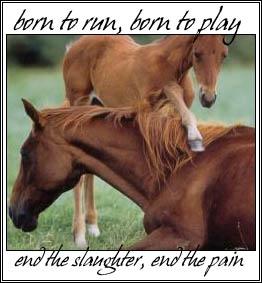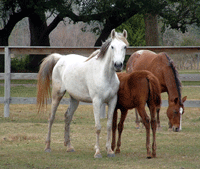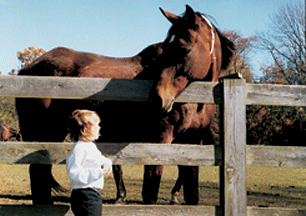Horse Slaughter - The Facts!
Background
Americans do not eat horses, nor do we raise them for food. Most Americans support a ban on horse slaughter. Yet more than 100,000 horses were killed in the U.S. in 2006 at three foreign-owned slaughterhouses and tens of thousands more were exported for slaughter abroad. The meat comes from pet horses, work horses, race horses and even wild horses and is sold for human consumption in Europe and Asia where it is considered a delicacy.
The Status of Horse Slaughter
Until recently, three horse slaughterhouses existed in the U.S., two in Texas and one and Illinois. All three were foreign owned, and the meat from the slaughtered horses was sent overseas. Impatient at the inability of the federal government to ban the industry, the Texas plants were effectively shuttered in 2007 when Texas began enforcing a 1949 state law prohibiting horse slaughter. Illinois passed a similar law in 2007 and the slaughter stopped there, too. The result was a steep decline in the number of horses slaughtered in the U.S. in 2007 (just under 30,000). However, horses were and continue to be shipped out of the country for slaughter in Mexico, Canada and further abroad, in sharply increasing numbers, with more than 100,000 being brutally butchered last year.
Immense Cruelty
The suffering of horses in slaughter, whether here or abroad, is horrendous. But while the process in domestic slaughterhouse whereby horses were often hit in the head with the captive bolt gun multiple times before being strung up for bleeding out and quartering (sometimes while still conscious) the grisly scene in Mexican slaughterhouses is yet worse. A 2007 investigation by The Humane Society of the United States revealed that horses are literally stabbed to death in Mexican slaughterhouses. To view video footage of the treatment, go to http://www.hsus.org/horses_equines/mexico_slaughter_100407.html (warning: graphic content). The findings are echoed in a story by Lisa Sandberg that ran in the San Antonio News Express in October, 2007 in which she wrote:
"The American mare swung her head frantically when the door shut to the kill box, trapping her inside. A worker jabbed her in the back with a small knife – seven, eight, nine times. Eyes wild, she lowered her head and raised it as the blade punctured her body around the withers, again and again. At the 10th jab, she fell to the floor of this Mexican slaughterhouse, bloodied and paralyzed, but not yet dead. She would lay a good two minutes before being hoisted from a chained rear leg so her throat could be slit and she could bleed to death."
How Horses End Up at Slaughter
Most American horses going to slaughter, whether slaughtered here, in Mexico or elsewhere, arrive at the slaughterhouse via livestock auctions where they are bought by "killer-buyers" working for the slaughter plants. The killer-buyers travel from auction to auction to collect horses they can then sell to the slaughterhouses at a profit. These killer-buyers have a financial incentive to outbid other potential purchasers of the horse, and many individuals selling their horses at auction are unaware that they risk placing their horses in the hands of killer buyers simply by entering them into the auction ring. Few horse owners electively sell their horses to slaughter.
Much of the domestic transport of horses to slaughter is unregulated, with only the final leg of the journey to the slaughterhouse covered by federal regulations. This means that slaughter-bound horses continue to be moved on double-deck trailers designed for cattle and pigs in direct violation of Congressional intent. Not only are the conveyances dangerously top-heavy and have been the cause of multiple fatal accidents but they are fundamentally inhumane for transporting equine, forcing many horses to travel in a bent position. The portion of the journey to slaughter which is regulated by the government allows horses to be shipped for more than 24 hours at a time without food, water or rest. Foals, heavily pregnant mares, horses with broken legs and blind horses can be moved, under the regulations.
The U.S. Department of Agriculture is now seeking to broaden the scope of its transport regulations to cover all segments of the journey to slaughter so as to finally ban the use of double-deckers but it is too little too late, particularly given that the domestic horse slaughter plants have been shut down. The United States government has no authority to regulate the treatment of horses once they cross the border and are outside of U.S. territory.
The Remedy – Passage of federal legislation
The American Horse Slaughter Prevention Act (AHSPA) prohibits the transport and sale of horses to slaughter for human consumption, effectively halting their slaughter here and export for slaughter abroad. First introduced in 2001 - AHSPA - (S. 311 in the Senate, H.R. 503 in the House) has steadily gained public and Congressional support with the U.S. House of Representatives overwhelmingly passing the bill in the 109th Congress. Related measures designed to stop horse slaughter have also received widespread Congressional support including a spending restriction to the FY 2006 Agriculture Appropriations bill designed to stop slaughter by withdrawing federal funds for legally mandated inspections. It passed both the House and Senate by a landslide but was circumvented by the U.S. Department of Agriculture. A similar amendment is in the FY 2008 Omnibus Appropriations Bill.
More recently, The Prevention of Equine Cruelty Act of 2008 (PECA) was introduced in the House by Judiciary Committee Chairman John Conyers, Jr. (D-MI) and Representative Dan Burton (R-IN). The bill (H.R. 6598) would ban horse slaughter by amending Title 18 of the US Code thus providing the federal government and law enforcement officials with the tools necessary to ensure that American horses are protected from the brutal practice of slaughter. The bill carries criminal penalties for the purchase, sale, delivery or export of horsemeat intended for human consumption.
Yet the slaughter continues in the absence of final passage of either federal bill, in large part because the American Veterinary Medical Association (AVMA), the American Association of Equine Practitioners (AAEP) and the foreign-owned slaughterhouses continue to defend slaughter in the face of public and professional opinion. The majority of Americans, the humane community, much of the equestrian community and dozens and dozens of celebrities and corporate leaders support passage of the bill, as does the majority of the United States Congress.
What You Can Do
* Contact your elected officials
Please call or email your elected officials and ask them to cosponsor the American Horse Slaughter Prevention Act (S. 311/H.R. 503) and the Prevention of Equine Cruelty Act ( H.R. 6598). To send an e-letter, or to find out more about contacting your elected representatives, click on one or both of the links below.
AWI’s Compassion Index (go to) http://www.compassionindex.com
HSUS (go to) http://www.hsus.org/legislation_laws
* Register your support for the American Horse Slaughter Prevention Act
If you are with an equine rescue organization or work in the equestrian sector and wish to have your business or organization’s name added to the list of those supporting federal legislation to end horse slaughter, please send us an email, our email address is: info@homesforhorses.org
Are you doing all you can to make this world a better place to live in?
Subscribe to:
Post Comments (Atom)







No comments:
Post a Comment